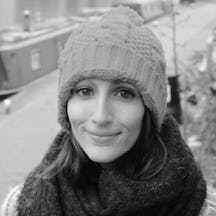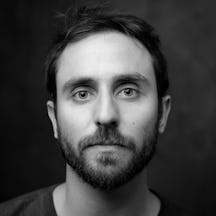Meet Gayle Price, a glassblower whose work for chemists, physicists and medics shows that craft skills and creative thinking are essential to science.

Wearing a knee-length white lab coat and wraparound shades, her long hair clipped back, Gayle Price adjusts the amount of gas and oxygen flowing into her burner. It has the look of a blowtorch, but one fixed in place and with six different outlets. The wavering orange flame that’s shooting out of it becomes fierce blue and sharp as a pin, its dull roar now a hiss.
Holding a 1.5-metre-long glass rod in one hand – hollow, with a 7 mm diameter – and a much shorter, thicker solid metal rod in the other, she starts heating the glass in the flame. As it glows and softens, she begins coiling it evenly around the metal. Her movements are quick but rhythmic. She works by eye alone.

As Gayle works at the burner, a spiral forms in the heat, each twist and turn symmetrical.
Gayle hasn’t always worked with glass for a living, but she now can’t see herself doing anything else. She studied photography at school, then trained as a painter and decorator. After that she worked as a bouncer in Glasgow for a couple of years, but found night shifts increasingly tough.
Wondering what to do with her life one day, she saw an advert in the paper for an apprentice scientific glassblower, a scheme run jointly by the universities of Edinburgh and Glasgow. She was intrigued, so applied and got the job, which was based in East Kilbride.
More: The futurists using artificial intelligence to try and 'remember' an entire human life.
Under the direction of William McCormack – a glassblower who appreciated the importance of passing on his knowledge, nurturing five apprentices before he retired – Gayle cut her teeth making spiral taps for filtering gases, while also studying applied science on day release at college. The instruments she was making reminded her of the ones that often featured in the old horror films she loved watching with her dad.
During her training, Gayle realised that she’d always wanted to work with her hands like this, and that the promise of having her own workshop one day was compelling.

Gayle’s apprenticeship made her realise that she’d always wanted to work with her hands.
Step into Gayle’s current workshop at the University of Leicester and the joy of having a room of one’s own in which to work is easy to see. Packed with glassware of all sorts, and the tools required to manipulate it into a multitude of shapes, she’s made this practical basement space immensely personal.
There are posters and postcards all over the walls, and stickers decorating the burners and lathes. Teardrops of glass have peacock feathers trapped inside, glitter-encrusted glass flasks have wings. It’s Gayle’s space, but she’s not in the least bit territorial. She’s more than happy for me to poke around.

As Gayle works at the burner, a spiral forms in the heat, each twist and turn symmetrical. In her hands, something I think of as rigid and fixed becomes elastic, amorphous. The coil complete, she removes the entwined metal and glass from the flame and places them on a rack to cool. In a few minutes the metal will contract, allowing the glass to slip off easily.
Gayle takes another 1.5-metre length of hollow glass rod. Using a stubby knife with a tungsten carbide blade, she slices into it, leaving a deep scratch in the surface. She snaps the glass along this groove. Slowly spinning a now shorter length of glass between forefinger and thumb, she inserts one end into the burner’s 1,220°C heat.
Surrounded by flame, the end brightens, becomes liquid-looking, and eventually seals off. Despite being far from the flame, the other, still-open end of the rod glows. Instinct tells Gayle when to pull the glass out of the flame and press that orange, open tip to her lips.
I gasp, anticipating seared flesh. She blows, gently at first, then harder. A beautiful bubble grows at the rod’s opposite, softened tip. A perfect sphere, swelling out evenly under her steady breath. The end she blew into was in fact cool; glass is a good insulator and that orange glow just a fibre-optic trick of the light. She places the finished bubble alongside the spiral on the rack.
In pictures

In the flame, an everyday material that we think of as rigid becomes soft and bendy.

Instinct tells Gayle when to pull the glass rod out of the flame and start blowing.

Gayle’s glass-working tools, lined up on her workbench.

Blown glass left to cool.

This machine reveals points of stress and strain in a piece of glass.

Hollow glass rods of all shapes and sizes are the raw material for Gayle’s commissions and creations.
Working mainly for the university’s chemistry department, but also for physics and medicine, Gayle makes a mixture of standard and bespoke glass instruments to order, as well as fixing broken glassware from the teaching labs. Glass is an excellent material for scientific equipment: it’s durable, transparent, non-reactive, and easy to sterilise in the oven.
Gayle also collaborates with artists, recently working with a ceramicist and a jewellery designer on two projects for British Science Week. One resulted in delicate fungi-like structures made from white porcelain and clear glass, the other a large sculpture of reindeer lichen, rendered in green and clear glass.
Gayle savoured the chance to work differently, although admits it did feel odd to deliberately introduce flaws. “I usually work to very exacting parameters,” she explains. “It was different to be asked to just explore, to not create something regular. And good to be reminded how beautiful and versatile glass can be.”

Gayle makes a mixture of standard and bespoke glass instruments to order, while artist commissions remind her of glass’s elasticity, versatility and beauty.
Watching Gayle work, it’s clear that to be a scientific glassblower you need to be a problem-solver, and a logical but creative thinker. You need to be patient, dexterous and able to control your breath. Gayle’s scientific job involves much artistry.
Her enthusiasm is infectious, so when she invites me to have a go, I can’t resist. Putting on her spare set of wraparound shades – these have a special coating that allows you to see the glass more clearly in the flame – I ready myself in front of the burner.
Gayle sets me five tasks: cutting a glass rod, softening a sharp edge, creating a test-tube end, blowing a sphere, and making a bend. All of it is far, far harder than she makes it look, especially the blowing. Getting the glass to bubble out seems impossible at first. Gayle eggs me on – “Blow harder! Harder!” – and eventually I squeeze out a tiny, lopsided sphere. It’s pathetic, but I’m proud.
Watching – but most of all feeling – the glass transform in the flame is fascinating. I now understand more clearly what Gayle means about this everyday material’s elasticity, versatility and beauty.

Exciting things happen when art, craft, engineering and science collide.
I ask Gayle about the places where art and science meet, and whether she would ever consider herself to be an artist or craftsperson. “The intersections between art and science are undeniable,” she says. “Both are about discovery, exploring the unknown, making something new. As a scientific glassblower, I like the freedom to be both a craftsperson and an engineer.”
-
Enjoy this article connecting science and art? If you're in London, you might also like our exhibition Somewhere in Between, at Wellcome Collection until 27 August 2018.
About the contributors
Helen Babbs
Helen is a Digital Editor for Wellcome Collection.
Thomas S G Farnetti
Thomas is a London-based photographer working for Wellcome. He thrives when collaborating on projects and visual stories. He hails from Italy via the North East of England.

